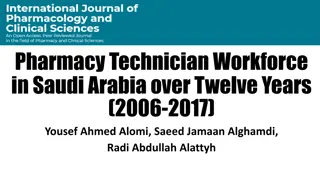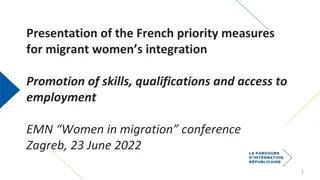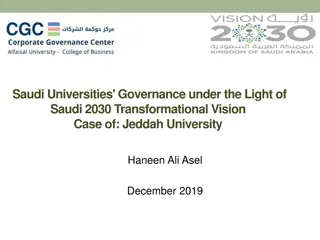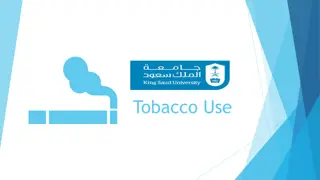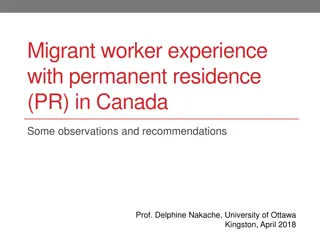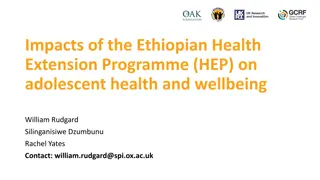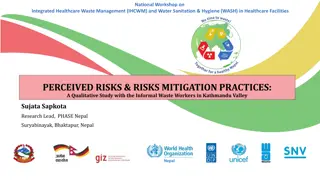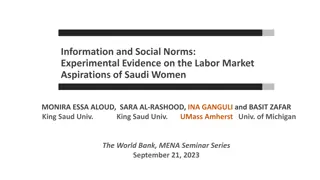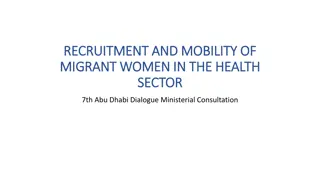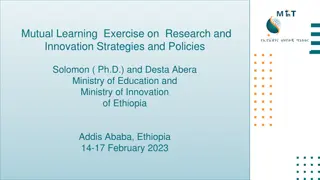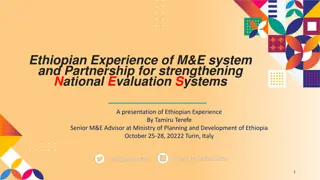Challenges Faced by Ethiopian Migrant Workers in Saudi Arabia
Significant growth in low-skilled labor migration from Ethiopia to Saudi Arabia has raised concerns due to poor working conditions and human rights violations. This migration shift is influenced by government policies and economic factors in destination countries. Reasons for migration include poverty, lack of opportunities, and high demand for labor. Characteristics of migrants show a trend of youth and uneducated individuals. The situation calls for better protection and support for Ethiopian workers abroad.
Download Presentation

Please find below an Image/Link to download the presentation.
The content on the website is provided AS IS for your information and personal use only. It may not be sold, licensed, or shared on other websites without obtaining consent from the author. Download presentation by click this link. If you encounter any issues during the download, it is possible that the publisher has removed the file from their server.
E N D
Presentation Transcript
Sampling frameworks for survey returnees from Saudi Arabia: Ethiopia Adamnesh Atnafu (PhD) Addis Ababa University
Country context of low-skilled labor migration Over the past two decades significant growth in international flows of labour from Ethiopia, mostly of low skilled persons. Unfortunately, the growth in labour demand has not resulted in an improvement of the conditions of Ethiopian migrant workers - Restrictive immigration policies, commercialization of migration processes, increasing trafficking and smuggling of migrants have all increased significantly. There has been serious infringment of rights of migrants in the process .
Country context contd: destination shift Migration of Ethiopian workers, mostly of domestic workers has shifted from a predominantly Lebanon and to some extent Syria in the 1990s and early 2000 to Saudi Arabia in the last two years. This shift is partly due to the ban that the Government of Ethiopia has made on labour migration to Lebanon. The number of migrants has increased in two folds from 2010-2013 excluding irregular migrants
Number of migrant workers who have processed their migration through PEAs per year and country of destination 2001 J.C. (8 Jul '08 - 7 Jul '09 2002 J.C. (8 Jul '09 - 7 Jul '10 2003 J.C. (8 Jul '10 - 7 Jul '11 2004 J.C. (8 Jul '11 - 7 Jul '12 2005 J.C. (8 Jul '12 - 7 Jul '13 Country of destination Male Female Saudi Arabia 3749 9399 Kuwait 103 U.A.E. 9 Other countries 14 3875 17393 Male Female Male Female Male Female Male Female 1082 321 1 2396 10837 142 2030 13446 663 0 10341 270 109 158959 7127 28476 321 154660 20659 0 6976 113 25457 510 130 0 905 148 1552 19 13394 12 2705 39528 115 16 10736 175 187931 7269 12 108 175427
Country context contd Reasons for migration Rural and urban Poverty: Lack of means of production such as land (could be because of environmental degradation), lack of employment and means of income Lack of educational opportunities High demand for low-skilled labour at the destination The influence of already settled migrants at the destination on potential migrants The existence of the PEAs to facilitate the migration process
Country context contd Characteristics of low-skilled labor migrants: age/ gender/ education/ origin The group that migrates is youth within the age range of 20-25 for females while the males are mostly above the age of 30 - poor and uneducated. According to the data of the IOM (2014), the number of migrants was higher in Amhara followed by Oromiya and Tigray respectively. Addis Ababa was represented among the lowest number of migrants in comparison with the above three regions. Males constituted the higher number representing 62% of the returnees while females constituted 33%.
Country context contd Destinations and type of occupation The destination of all respondents was Saudi Arabia as per the objectives and scope of the survey. Transit routes - Djibouti and Yemen for who have migrated through illegal means. Males engaged in agriculture (farming and cattle herding) and construction labor Females were engaged in domestic work, kitchen assisting (cooking), and cleaning and helping at the house and/or at hotels. Few exceptions: Men worked as drivers and guards, females in construction work.
Country context contd Employment contract PEAs use employment contract for workers migrating to Kuwait. It is entered into by/between the employer, the agency and the employee. Contract: on salary, interval of payment, working hours, living conditions (leisure time, access to medical services, adequate food), life and medical insurance, free ticket to and from Ethiopia, termination, and alteration. No contract with employer in KSA PEAs sign on behalf of the employer - bilateral labour agreement with KSA.
Country context contd Proclamation No. 632/2009 January 2010 Demands the PEAs to protect the rights of citizens Minimum wage for migrant workers at 180 USD Not sign a contract with workers younger than 18 years of age Change the contract without the knowledge of the MOLSA As of 23 August 2013, the no. of PEAs is 406. Most of these PEAs have also branch offices in different towns Currently, most PEAs send workers to Saudi Arabia. 71 PEAs to both KSA and Kuwait, while 253 PEAs only to KSA
Country context contd Regular vs irregular migration Reasons for choosing irregular migration: distorted information on the costs of legal way, advice from smugglers and traffickers, long and bureaucratic processes of the legal route, charging of unlawful fees by PEAs Cost: irregular migration costs much more than regular migration Benefits: irregular migration has more benefit in terms of freedom, more wage, and unbound by contracts, better treatment by employers Migrants still want to migrate to the same destination as the opportunity materializes
Surveying and Sampling frame A team of 6 research assistants and a supervisor conducted the survey using the CAPI system. To properly coordinate the survey process and facilitate support among research team, all members were at each survey area at once. Research assistants were selected based on merits of education/experience.
Surveying contd The selection was based on previous work experience and regional affiliation to ensure language and cultural exposure of the regions. All have a minimum of first degree and adequate experience in surveys using the CAPI system. Research assistants received training on the CAPI system and discussions on the details of the questionnaire to have the same understanding of the tool
Sampling frame Most commonly used sampling frames for migration surveys are stock of migrants, population census/registers; and flows of migrants/border statistics. Ethiopian returnees from KSA as arrived at Bole International Airport are considered in proposing the sampling design - border statistics. It permits drawing a sample of areas where returnees are concentrated, making the survey less costly while maintaining representativeness.
Sampling frame contd Other similar studies conducted - Collect contact information from returnees upon their arrival at the airports and the other possible way is to undertake the full interview at the airport upon return. In this particular case of Ethiopian returnees, the challenge is that they have already been dispersed to their respective areas of origin and difficult to locate them; this makes it impracticable to use either of the above methods as used by the other countries yet they left contact addresses at the offices
Sampling frame contd Even though the number is known on the basis of those who have arrived through Bole International Airport - no statistical record of the updated number Contact addresses of most - not all - is available in the regional and zonal offices can this be employed as a sampling frame? Interviewers were able to call people on the phone in terms of randomized selection. Yet, when the non-response is substantially high, interviewers were obliged to call for substitutes of the randomly selected participants. Thus, in such cases, the final sample of respondents is considered as a non- probability sample
Sampling frame contd In the absence of a reliable sampling framework, it is suggested that purposive sampling be applied according to returnee s region of origin. The survey was therefore undertaken in returnee communities of three regions and the city administration of Addis Ababa where substantial number of returnees are reported according to IOM (2014) data Amhara, oromiya and Tigray. Due to financial and time limitations, returnees from other regions are not part of the study.
Selection criteria The data- collection was carried out in Ethiopia in three regions namely Amhara, Oromiya, Tigray, and the Addis Ababa. These are selected because highest number of migrants originated from these areas. Tracking participants based on areas of concentration is a feasible approach, which increases the possibility of obtaining higher response rate. The subjects of the study are Ethiopian returnees who have migrated to Saudi Arabia in the past 3-4 years.
Sampling Participants were contacted through phone, through families, friends, and acquaintances using the snowball method. Quota method was also applied according to returnee s age, sex, educational level and other differentiating factors. The actual ratio of males and females who were part of the research was 40% male and 60% females. The team has attempted to contact respondents as per IOM s sex proportion, however, significant number of males were out of reach, few stated that they are no longer in their respective areas. This shows the instance of re-migration within the country or even abroad.
Sample size According to IOM s registry, as of 24 March 2014, the number of Ethiopian returnees from Saudi Arabia was estimated to be approximately 163,018, - 62% males while 33% and 5% are females and children. The highest number of returnees is from Amhara region, followed by Oromia and Tigray compared to the rest of the regions. Yet, the number provided by this registry includes only those people registered to have arrived at Bole International Airport; this does not guarantee if they are still in the country in the absence of a follow up strategy.
Sample size contd As per an official at the MOLSA, they are scattered within the country where there is no systematic way of recording migratory movements. Possibility of re-migration either internally or internationally, as there is no system of knowing who have re-migrated and who have stayed. Number of Ethiopian returnees currently residing in the regions is not known as there is no comprehensive and updated statistical data recorded. Thus, probability random sampling remains difficult to apply.
Sample size contd The highest sample size for reliability of 5% error tolerated and 95% confidence level (percent in population assumed to be 50%) is 383 for population size more than 100,000 while it is 384 where it is estimated to be 500,000 or more (Hill, Roth & Arkin, 1962). The researcher preferred to take sample size 384 to ensure reliability. We have collected data from 400 to leave space for missing and unfit responses.
Lessons learnt and challenges CAPI advantages - its effect on interview duration, allowed the supervisor to closely monitor the survey and provide immediate feedback to interviewers. Willingness of migrants to take part in the study. The surveys took much lesser time than a paper and pen interviewing - contributing for motivation of participation. Locating migrants at the respective regions was difficult - updated data and follow- up is relevant Little or no reception of network in the rural areas of the regions, research assistants were not able to synchronize data as frequently as intended.
End Thank you



